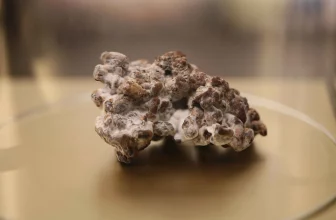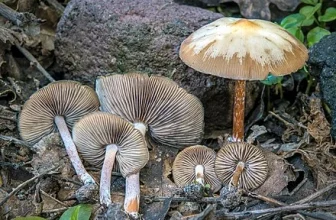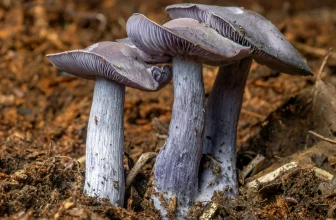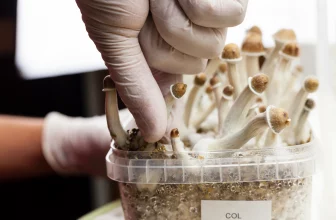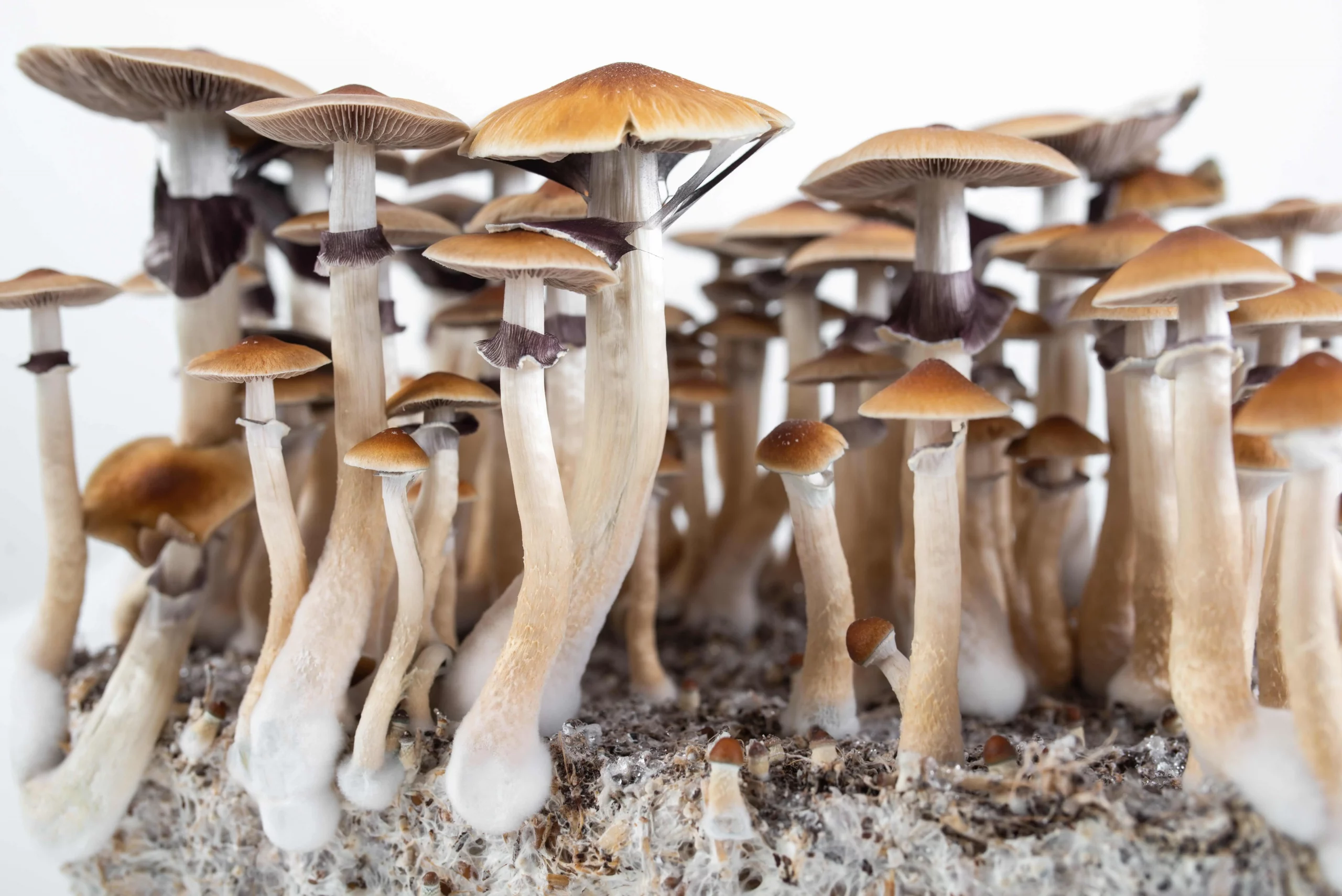
The most well-known magic mushroom is Psilocybe cubensis, sometimes called the Cubes mushroom strain. P. cubensis mushrooms have a long history of use, making them popular among psychedelic users. Let’s jump right in and take a look at the Cubes mushroom, where you can find it, and how potent they are.
What Is Psilocybin?
The two primary chemical components in magic mushrooms are psilocybin and psilocin. Psilocybin converts into the psychoactive compound psilocin when the body processes it, and psilocin is what causes the psychedelic effects.
Psilocin, which can pass through the blood-brain barrier because of its structural similarity to the neurotransmitters serotonin or dopamine, is one of the original psychedelics, along with LSD and mescaline.
The History of the Psilocybe Cubensis Mushroom Strain
The Psilocybe cubensis mushroom species was initially discovered in Cuba and later popularized by Terence McKenna, who called it the “starborn magic mushroom.” Dozens of Psilocybe cubensis strains are marketed today. These varieties include:
- Alacabenzi
- Albino A+
- B+ Cubensis
- Blue Meanie
- Burma
- Cambodian
- Costa Rican
- Ecuador Cubensis
- Enigma Cubensis
- Golden Teacher
- Mazatapec
- Penis Envy
- PES Amazonia
- PF Classic
- PF Redspore
- Pink Buffalo
- Orissa India
- Z-Strain
These shrooms are widely distributed and easy to cultivate. However, the P. cubensis strains differ in the quality and intensity of the experiences they offer, as well as in how well and quickly they grow, the conditions they prefer, and their color, size, and shape.
What Does a Psilocybe Cubensis Mushroom Look Like?
Because there are so many strains of Psilocybe cubensis mushrooms, they all look different. For example, some have a convex reddish-brown cap that is especially bulbous when young. As these mushrooms age, the cap becomes flat, and its color softens to a light brown color. The Golden Teacher strain of P. cubensis has a distinct appearance, with long, winding stems and wide caps.
Scientists are still discovering new species of magic mushrooms regularly. Compared to other organisms, fungi’s distribution, chemistry, and species diversity are all poorly understood.
Researchers continue to understand fungi better as more people become interested in foraging and contributing to citizen science data. But there is still a lot to discover about psychedelic mushrooms, so now is a great time to delve into the mycological world!
Where Is the Psilocybe Cubensis Mushroom Grown?
This trippy shroom belongs to a genus of primarily tiny, poo-loving species. Many Psilocybe cubensis varieties have been found growing in the wild or intentionally bred by growers.
Cubes mushrooms are widely distributed in tropical and subtropical regions around the world. They’re found in the southeastern United States, growing on cattle dung and well-manured land. Around the world, you can find P. cubensis in Central and South America, Mexico, Cuba, and parts of Asia and Australia.
The mushrooms grow not only on cow dung but also in or on sugar cane mulch or rich pasture soil. Psilocybe cubensis mushrooms are grown on water buffalo dung in Asia. In the northern hemisphere, they appear from February to December, and in the southern hemisphere, they emerge from November to April. The Cubes mushroom is the most widely grown psilocybin mushroom because it tolerates less-than-ideal growing conditions and produces excellent yields.
Common Effects of Cubes Mushrooms
- cubensis mushrooms are moderately potent, containing 0.37 to 1.30% psilocybin in the whole mushroom.
The psychedelic effects include enhanced or altered physical, auditory, and visual perceptions. Some additional effects are a distorted sense of time, greater empathy and a connection to others and the natural world, and mystical or spiritual experiences.
Depending on the dosage and environment, psychedelics can have profoundly personal and existential effects on the user. Some people refer to a “bad trip” as a side effect that includes disorientation, an elevated heart rate, anxiety, and paranoia. While others return to normal with no further problems, some have reported long-term effects from these negative experiences, such as flashbacks.
Calculating Dosages with Magic Mushrooms
Each mushroom strain has a different amount of psilocybin and a unique potency. Knowing the difference in magic mushroom strains matters because other Psilocybe species can have dramatically different strengths, either much stronger or weaker than one would expect.
Many people don’t distinguish between strains of P. cubensis and other Psilocybe species, discussing them as simply “types of shrooms.” It can be challenging or downright impossible to determine the proper doses without knowing the specific species of mushroom.
In general, Psilocybe cubensis contains moderate amounts of psilocybin. In comparison, Psilocybe azurenscens, considered the most potent type of psilocybin mushroom, has 1.78% psilocybin, while Psilocybe liniformans, a low-potency mushroom, has only 0.16% psilocybin. Due to their high potency, Psilocybe cubensis mushrooms are popular among users.
People with particular mental health conditions or other disorders should exercise caution when partying with magic mushrooms. We advise you to speak with a mental health expert who understands psychedelics and knows about your plan to dose. Psychedelics should be used with caution, especially when there are mental health concerns.
Set and setting are fundamentally important, as is having a sitter. Microdosing has particular benefits, but you should take caution to dose carefully based on species. Choosing species for microdosing can be tricky. Many users seek a strong shroom strain because it requires much less dry material for microdosing.
Due to their structural similarity to serotonin or dopamine, which can enhance neuroplasticity and improve brain functions like cognition, learning, and memory, both psilocybin and LSD are well-liked options for microdosing.
Psilocybe cubensis is a moderately potent psychedelic, so dosages for this species of mushrooms will be different from those for other, more potent (and less potent) species.
- A microdose is 0.1g to 0.2g.
- A mild dose is 0.25g to 1g.
- A moderate dose is 1g to 2.5g.
- A strong dose is more than 2.5g.
If you’re taking 3.5g or more of Psilocybe cubensis mushrooms, the dose may be high enough to induce a mystical experience.
Before Tripping, Know This
Your experience during a Psilocybe cubensis mushroom trip can have various effects. Of course, the dose you take will significantly impact how strong these effects are.
However, the results will also differ depending on your personality, state of mind, current situation, expectations and intentions, and the environment. Think about who you’ll be with if you need a sitter, where you’ll be, and what kind of music or activities will keep you engaged.
Magic mushrooms have a wide range of effects. You might feel powerful emotions and giddiness, notice brighter colors, and hear new and wonderful sounds. There’s no way to gauge whether one mushroom species has a different impact than another besides potency.


